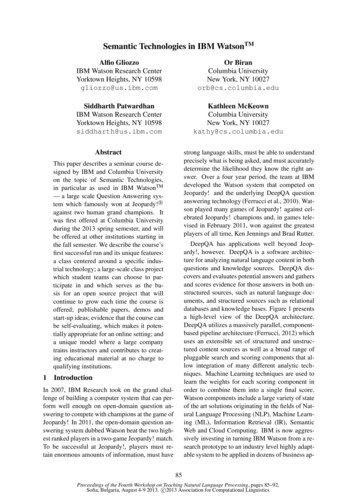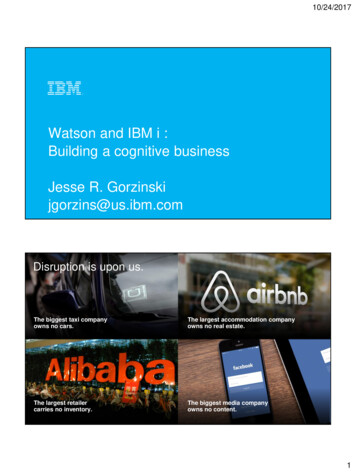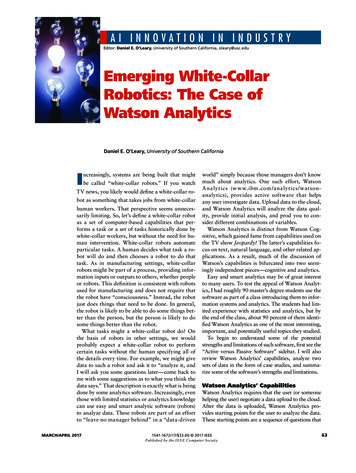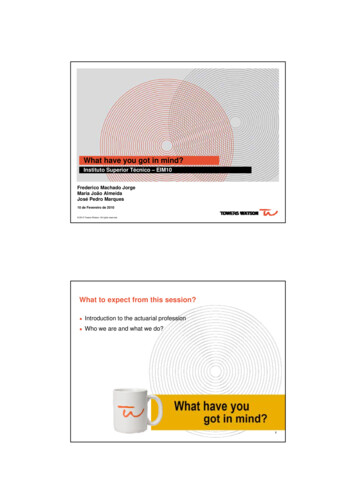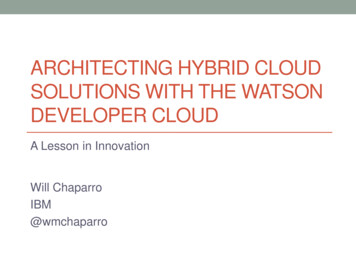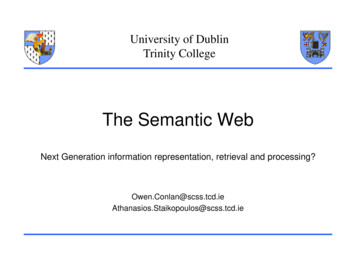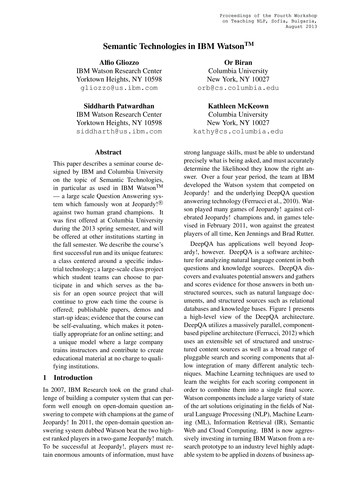
Transcription
Proceedings of the Fourth Workshopon Teaching NLP, Sofia, Bulgaria,August 2013Semantic Technologies in IBM WatsonTMAlfio GliozzoIBM Watson Research CenterYorktown Heights, NY 10598gliozzo@us.ibm.comOr BiranColumbia UniversityNew York, NY 10027orb@cs.columbia.eduSiddharth PatwardhanIBM Watson Research CenterYorktown Heights, NY 10598siddharth@us.ibm.comKathleen McKeownColumbia UniversityNew York, NY 10027kathy@cs.columbia.eduAbstractThis paper describes a seminar course designed by IBM and Columbia Universityon the topic of Semantic Technologies,in particular as used in IBM WatsonTM— a large scale Question Answering system which famously won at Jeopardy! Ragainst two human grand champions. Itwas first offered at Columbia Universityduring the 2013 spring semester, and willbe offered at other institutions starting inthe fall semester. We describe the course’sfirst successful run and its unique features:a class centered around a specific industrial technology; a large-scale class projectwhich student teams can choose to participate in and which serves as the basis for an open source project that willcontinue to grow each time the course isoffered; publishable papers, demos andstart-up ideas; evidence that the course canbe self-evaluating, which makes it potentially appropriate for an online setting; anda unique model where a large companytrains instructors and contribute to createeducational material at no charge to qualifying institutions.1IntroductionIn 2007, IBM Research took on the grand challenge of building a computer system that can perform well enough on open-domain question answering to compete with champions at the game ofJeopardy! In 2011, the open-domain question answering system dubbed Watson beat the two highest ranked players in a two-game Jeopardy! match.To be successful at Jeopardy!, players must retain enormous amounts of information, must havestrong language skills, must be able to understandprecisely what is being asked, and must accuratelydetermine the likelihood they know the right answer. Over a four year period, the team at IBMdeveloped the Watson system that competed onJeopardy! and the underlying DeepQA questionanswering technology (Ferrucci et al., 2010). Watson played many games of Jeopardy! against celebrated Jeopardy! champions and, in games televised in February 2011, won against the greatestplayers of all time, Ken Jennings and Brad Rutter.DeepQA has applications well beyond Jeopardy!, however. DeepQA is a software architecture for analyzing natural language content in bothquestions and knowledge sources. DeepQA discovers and evaluates potential answers and gathersand scores evidence for those answers in both unstructured sources, such as natural language documents, and structured sources such as relationaldatabases and knowledge bases. Figure 1 presentsa high-level view of the DeepQA architecture.DeepQA utilizes a massively parallel, componentbased pipeline architecture (Ferrucci, 2012) whichuses an extensible set of structured and unstructured content sources as well as a broad range ofpluggable search and scoring components that allow integration of many different analytic techniques. Machine Learning techniques are used tolearn the weights for each scoring component inorder to combine them into a single final score.Watson components include a large variety of stateof the art solutions originating in the fields of Natural Language Processing (NLP), Machine Learning (ML), Information Retrieval (IR), SemanticWeb and Cloud Computing. IBM is now aggressively investing in turning IBM Watson from a research prototype to an industry level highly adaptable system to be applied in dozens of business ap-
Figure 1: Overview of the DeepQA architectureplications ranging from healthcare to finance (Ferrucci et al., 2012).Finding that particular combination of skills inthe entry-level job market is hard: in many casesstudents have some notion of Machine Learningbut are not strong in Natural Language Processing;in other cases they have background in KnowledgeManagement and some of the basics of SemanticWeb, but lack an understanding of statistical models and Machine Learning. In most cases semanticintegration is not a topic of interest, and so understanding sophisticated platforms like ApacheUIMATM (Ferrucci and Lally, 2004) is a challenge. Learning how to develop the large scale infrastructure and technology needed for IBM Watson prepares students for the real-world challengesof large-scale natural language projects that arecommon in industry settings and which studentshave little experience with before graduation.Of course, IBM is interested in hiring entrylevel students as a powerful way of scaling Watson. Therefore, it has resolved to start an educational program focused on these topics. Initially, tutorials were given at scientific conferences(NAACL, ISWC and WWW, among others), universities and summer schools. The great numberof attendees (usually in the range of 50 to 150)and strongly positive feedback received from thestudents was a motivation to transform the didactic material collected so far into a full graduate-level course, which has been offered for the firsttime at Columbia University. The course (whichis described in the rest of this paper) received verypositive evaluations from the students and will beused as a template to be replicated by other partner universities in the following year. Our ultimategoal is to develop high quality didactic materialfor an educational curriculum that can be used byinterested universities and professors all over theworld.2Syllabus and Didactic MaterialThe syllabus1 is divided equally between classesspecifically on the Watson system, its architecture and technologies used within it, and classeson more general topics that are relevant to thesetechnologies. In particular, background classes onNatural Language Processing; Distributional Semantics; the Semantic Web; Domain Adaptationand the UIMA framework are essential for understanding the Watson system and producing successful projects.The course at Columbia included four lecturesby distinguished guest speakers from IBM, whichwere advertised to the general Columbia community as open talks. Instead of exams, the courseincluded two workshop-style presentation days:one at the mid term and another at the end of the1The syllabus is accessible on line http://www.columbia.edu/ ag3366
course. During these workshops, all student teamsgave presentations on their various projects. At themid-term workshop, teams presented their projectidea and timeline, as well as related work and thestate-of-the-art of the field. At the final workshop,they presented their completed projects, final results and demos. This workshop was also madeopen to the Columbia community and in particular to faculty and affiliates interested in start-ups.The workshops will be discussed in further detailin the following sections. The syllabus is brieflydetailed here. Introduction: The Jeopardy! ChallengeThe motivation behind Watson, the task andits challenges (Prager et al., 2012; Tesauro etal., 2012; Lewis, 2012). The DeepQA Architecture Chu-Carroll etal. (2012b), Ferrucci (2012), Chu-Carroll etal. (2012a), Lally et al. (2012). Natural Language Processing BackgroundPre-processing, tokenization, POS tagging,named entity recognition, syntactic parsing,semantic role labeling, word sense disambiguation, evaluation best practices and metrics. Natural Language Processing in WatsonMurdock et al. (2012a), McCord et al. (2012). Structured Knowledge in Watson Murdocket al. (2012b), Kalyanpur et al. (2012), Fan etal. (2012). Semantic Web OWL, RDF, Semantic Webresources. Domain Adaptation Ferrucci et al. (2012). UIMA The UIMA framework, Annotators,Types, Descriptors, tools. Hands-on exercisewith the class project architecture (Epstein etal., 2012). Midterm Workshop Presentations of eachteam’s project idea and their research into related work and the state of the art. Distributional Semantics Miller et al.(2012), Gliozzo and Isabella (2005). Machine Learning and Strategy in Watson What Watson Tells Us About CognitiveComputing Final Workshop Presentations of eachteam’s final project implementation, evaluation, demo and future plans.3Watson-like Architecture for ProjectsThe goal of the class projects was for the students to learn to design and develop language technology components in an environment very similar to IBM’s Watson architecture. We providedthe students with a plug-in framework for semantic search, into which they could integrate theirproject code. Student projects will be describedin the following section. This section details theframework that was made available to the studentsin order to develop their projects.Like the Watson system, the project frameworkfor this class was built on top of Apache UIMA(Ferrucci and Lally, 2004)2 — an open-sourcesoftware architecture for building applications thathandle unstructured information.The Watson system makes extensive use ofUIMA to enable interoperability and scale-out of alarge question answering system. The architecture(viz., DeepQA) of Watson (Ferrucci, 2012) definesseveral high-level “stages” of analysis in the processing pipeline, such as Question and Topic Analysis, Primary Search, Candidate Answer Generation, etc. Segmentation of the system into highlevel stages enabled a group of 25 researchers atIBM to independently work on different aspectsof the system with little overhead for interoperability and system integration. Each stage of thepipeline clearly defined the inputs and outputs expected of components developed for that particular stage. The researchers needed only to adhereto these input/output requirements for their individual components to easily integrate them intothe system. Furthermore, the high-level stages inWatson, enabled massive scale-out of the systemthrough the use of the asynchronous scaleout capability of UIMA-AS.Using the Watson architecture for inspitration,we developed a semantic search framework for theclass projects. As shown in Figure 2, the framework consists of a UIMA pipeline that has severalhigh-level stages (similar to those of the Watsonsystem):2http://uima.apache.org
Figure 2: Overview of the class project framework1. Query Analysis2. Primary Document Search3. Structured Data Search4. Query Expansion5. Expanded Query Analysis6. Secondary Document SearchThe input to this system is provided by a QueryCollection Reader, which reads a list of searchqueries from a text file. The Query Collection Reader is a UIMA “collection reader” thatreads the text queries into memory data structures (UIMA CAS structures) — one for eachtext query. These UIMA CASes flow through thepipeline and are processed by the various processing stages. The processing stages are set up sothat new components designed to perform the taskof each processing stage can easily be added to thepipeline (or existing components easily modified).The expected inputs and outputs of components ineach processing stage are clearly defined, whichmakes the task of the team building the componentsimpler: they no longer have to deal with managing data structures and are spared the overheadof converting from and into formats of data exchanged between various components. All of theoverhead is handled by UIMA. Furthermore, someof the processing stages generate new CAS structures and the flow of all the UIMA CAS structuresthrough this pipeline is controlled by a “Flow Controller” designed by us for this framework.The framework was made available to each ofthe student teams, and their task was to buildtheir project by extending this framework. Eventhough we built the framework to perform semantic search over a text corpus, many of the teamsin this course had projects that went far beyondjust semantic search. Our hope was that each teamwould be able to able independently develop interesting new components for the processing stagesof the pipeline, and at the end of the course wewould be able to merge the most interesting components to create a single useful application. In thefollowing section, we describe the various projectsundertaken by the student teams in the class, whileSection 5 discusses the integration of componentsfrom student projects and the demo applicationthat resulted from the integrated system.4Class ProjectsProjects completed for this course fall into threetypes: scientific projects, where the aim is toproduce a publishable paper; integrated projects,where the aim is to create a component that will beintegrated into the class open-source project; andindependent demo projects, where the aim is toproduce an independent working demo/prototype.The following section describes the integratedprojects briefly.4.1 Selected Project DescriptionsAs described in section 3, the integrated classproject is a system with an architecture which, although greatly simplified, is reminiscent of Watson’s. While originally intended to be simply asemantic search tool, some of the student teamscreated additional components which resulted ina full question answering system. Those projects
as well as a few other related ones are describedbelow.Question Categorization: Using the DBPediaontology (Bizer et al., 2009) as a semantictype system, this project classifies questionsby their answer type. It can be seen as a simplified version of the question categorizationsystem in Watson. The classification is basedon a simple bag-of-words approach with afew additional features.Answer Candidate Ranking: Given the answertype as well as additional features derived bythe semantic search component, this projectuses regression to rank the candidate answers which themselves come from semanticsearch.Twitter Semantic Search: Search in Twitter isdifficult due to the huge variations amongtweets in lexical terms, spelling and style, andthe limited length of the tweets. This projectemploys LSA (Landauer and Dumais, 1997)to cluster similar tweets and increase searchaccuracy.Fine-Grained NER in the Open Domain: Thisproject uses DBPedia’s ontology as a typesystem for named entities of type Person.Given results from a standard NER system,it attempts to find the fine-grained classification of each Person entity by finding the mostsimilar type. Similarity is computed usingtraditional distributional methods, using thecontext of the entity and the contexts of eachtype, collected from Wikipedia.News Frame Induction: Working with a largecorpus of news data collected by ColumbiaNewsblaster, this team used the MachineLinking API to tag entities with semantictypes. From there, they distributionally collected ”frames” prevalent in the news domain such as ’[U.S President] meeting with[British Prime Minister]’.Other projects took on problems such as SenseInduction, NER in the Biomedical domain, Semantic Role Labeling, Semantic Video Search,and a mobile app for Event Search.5System Integration and DemonstrationThe UIMA-based architecture described in section3 allows us to achieve a relatively easy integration of different class projects, independently developed by different teams, in a common architecture and expose their functionality with a combined class project demo. The demo is a collaboratively developed semantic search engine whichis able to retrieve knowledge from structured dataand visualize it for the user in a very concise way.The input is a query; it can be a natural languagequestion or simply a set of keywords. The outputis a set of entities and their relations, visualizedas an entity graph. Figure 3 shows the results ofthe current status of our class project demo on thefollowing Jeopardy! question.This nation of 200 million has foughtsmall independence movements likethose in Aceh and East Timor.The output is a set of DBPedia entities related tothe question, grouped by Type (provided by theDBPedia ontology). The correct answer, “Indonesia”, is among the candidate entities of type Place.Note that only answers of type Place and Agenthave been selected: this is due to the question categorization component, implemented by one of thestudent teams, that allows us to restrict the generated answer set to those answers having the righttypes.The demo will be hosted for one year following the end of the course at http://watsonclass.no-ip.biz. Our goal is toincrementally improve this demo, leveraging anynew projects developed in future versions of thecourse, and to build an open source software community involving students taking the course.6EvaluationThe course at Columbia drew a relatively large audience. A typical size for a seminar course on aspecial topic is estimated at 15-20 students, whileours drew 35. The vast majority were Master’s students; there were also three PhD students and fiveundergraduates.During the student workshops, students wereasked to provide grades for each team’s presentation and project. After the instructor independently gave his own grades, we looked at the correlation between the average grades given by thestudents and those give by the instructor. While
Figure 3: Screenshot of the project demo
TeamInstructor’s gradeTA’s gradeClass’ average grade1B B B/B 2BBB /A-3C BB/B 4AAA-5BBB/B 6A AA-7BBB 8BB A-/A9B B B /A-10AAA-/A11BC B/B Table 1: Grades assigned to class projectsthe students tended to be more “generous” (theiraverage grade for each team was usually half agrade above the instructor’s), the agreement wasquite high. Table 1 shows the grades given by theinstructor, the teaching assistant and the class average for the midterm workshop.Feedback about the course from the studentswas very good. Columbia provides electoniccourse evaluations to the students which are completely optional. Participation in the evaluation forthis course was just under 50% in the midtermevaluation and just over 50% in the final evaluation. The scores (all in the 0-5 range) givenby the students in relevant categories were quitehigh: “Overall Quality” got an average score of4.23, “Amount Learned” got 4, “Appropriatenessof Workload” 4.33 and “Fairness of Grading Process” got 4.42.The course resulted in multiple papers that areor will soon be under submission, as well as a fewprojects that may be developed into start-ups. Almost all student teams agreed to share their codein an open source project that is currently beingset up, and which will include the current questionanswering and semantic search system as well asadditional side projects.7ConclusionWe described a course on the topic of SemanticTechnologies and the IBM Watson system, whichfeatures a diverse curriculum tied together by itsrelevance to an exciting, demonstrably successfulreal-world system. Through a combined architecture inspired by Watson itself, the students get theexperience of developing an NLP-heavy component with specifications mandated by the largerarchitecture, which requires a combination of research and software engineering skills that is common in the industry.An exciting result of this course is that theclass project architecture and many of the studentprojects are to be maintained as an open sourceproject which the students can, if they choose,continue to be involved with. The repository andcommunity of this project can be expected to groweach time the class is offered. Even after one class,it already contains an impressive semantic searchsystem.Feedback for this course from the studentswas excellent, and many teams have achievedtheir personal goals as stated at the beginning ofthe semester, including paper submissions, operational web demos and mobile apps.Our long term goal is to replicate this course inmultiple top universities around the world. WhileIBM does not have enough resources to alwaysdo this with its own researchers, it is instead going to provide the content material and the opensource code generated so far to other universities,encouraging professors to teach the course themselves. Initially we will work on a pilot phaseinvolving only a restricted number of professorsand researchers that are already in collaborationwith IBM Research, and eventually (if the positive feedback we have seen so far is repeated inthe pilot phase) give access to the same content toa larger group.ReferencesC. Bizer, J. Lehmann, G. Kobilarov, S. Auer, C. Becker,R. Cyganiak, and S. Hellmann. 2009. DBpedia—Crystallization Point for the Web of Data. Journalof Web Semantics: Science, Services and Agents onthe World Wide Web, 7(3):154–165, September.J. Chu-Carroll, J. Fan, B. Boguraev, D. Carmel,D. Sheinwald, and C. Welty. 2012a. Finding Needles in the Haystack: Search and Candidate Generation. IBM Journal of Research and Development,56(3.4):6:1–6:12.J. Chu-Carroll, J. Fan, N. Schlaefer, and W. Zadrozny.2012b. Textual Resource Acquisition and Engineering. IBM Journal of Research and Development,56(3.4):4:1–4:11.E. Epstein, M. Schor, B. Iyer, A. Lally, E. Brown, andJ. Cwiklik. 2012. Making Watson Fast. IBM Journal of Research and Development, 56(3.4):15:1–15:12.J. Fan, A. Kalyanpur, D. Gondek, and D. Ferrucci.2012. Automatic Knowledge Extraction from Documents. IBM Journal of Research and Development,56(3.4):5:1–5:10.
D. Ferrucci and A. Lally. 2004. UIMA: an Architectural Approach to Unstructured InformationProcessing in the Corporate Research Environment.Natural Language Engineering, 10(3-4):327–348.D. Ferrucci, E. Brown, J. Chu-Carroll, J. Fan,D. Gondek, A. Kalyanpur, A. Lally, J. W. Murdock,E. Nyberg, J. Prager, N. Schlaefer, and C. Welty.2010. Building Watson: An Overview of theDeepQA project. AI magazine, 31(3):59–79.D. Ferrucci, A. Levas, S. Bagchi, D. Gondek, andE. Mueller. 2012. Watson: Beyond Jeopardy. Artificial Intelligence (in press).D. Ferrucci. 2012. Introduction to “This is Watson”. IBM Journal of Research and Development,56(3.4):1:1–1:15.A. Gliozzo and T. Isabella. 2005. Semantic Domainsin Computational Linguistics. Technical report.A. Kalyanpur, B. Boguraev, S. Patwardhan, J. W.Murdock, A. Lally, C. Welty, J. Prager, B. Coppola, A. Fokoue-Nkoutche, L. Zhang, Y. Pan, andZ. Qiu. 2012. Structured Data and Inference inDeepQA. IBM Journal of Research and Development, 56(3.4):10:1–10:14.A. Lally, J. Prager, M. McCord, B. Boguraev, S. Patwardhan, J. Fan, P. Fodor, and J. Chu-Carroll. 2012.Question Analysis: How Watson Reads a Clue. IBMJournal of Research and Development, 56(3.4):2:1–2:14.T. Landauer and S. Dumais. 1997. A Solution toPlato’s Problem: the Latent Semantic Analysis Theory of Acquisition, Induction and Representationof Knowledge. Psychological Review, 104(2):211–240.B. Lewis. 2012. In the Game: The Interface betweenWatson and Jeopardy! IBM Journal of Research andDevelopment, 56(3.4):17:1–17:6.M. McCord, J. W. Murdock, and B. Boguraev. 2012.Deep Parsing in Watson. IBM Journal of Researchand Development, 56(3.4):3:1–3:15.T. Miller, C. Biemann, T. Zesch, and I. Gurevych.2012. Using Distributional Similarity for LexicalExpansion in Knowledge-based Word Sense Disambiguation. In Proceedings of the International Conference on Computational Linguistics, pages 1781–1796, Mumbai, India, December.J. W. Murdock, J. Fan, A. Lally, H. Shima, andB. Boguraev. 2012a. Textual Evidence Gatheringand Analysis. IBM Journal of Research and Development, 56(3.4):8:1–8:14.J. W. Murdock, A. Kalyanpur, C. Welty, J. Fan, D. Ferrucci, D. Gondek, L. Zhang, and H. Kanayama.2012b. Typing Candidate Answers Using Type Coercion. IBM Journal of Research and Development,56(3.4):7:1–7:13.J. Prager, E. Brown, and J. Chu-Carroll. 2012. Special Questions and Techniques. IBM Journal of Research and Development, 56(3.4):11:1–11:13.G. Tesauro, D. Gondek, J. Lenchner, J. Fan, andJ. Prager. 2012. Simulation, Learning, and Optimization Techniques in Watson’s Game Strategies. IBM Journal of Research and Development,56(3.4):16:1–16:11.
Semantic Technologies in IBM Watson TM Alfio Gliozzo IBM Watson Research Center Yorktown Heights, NY 10598 . ardy!, however. DeepQA is a software architec-ture for analyzing natural language content in both questions and knowledge sources. . Pre-processing, tokenization, POS tagging, named entity recognition, syntactic parsing, semantic .
